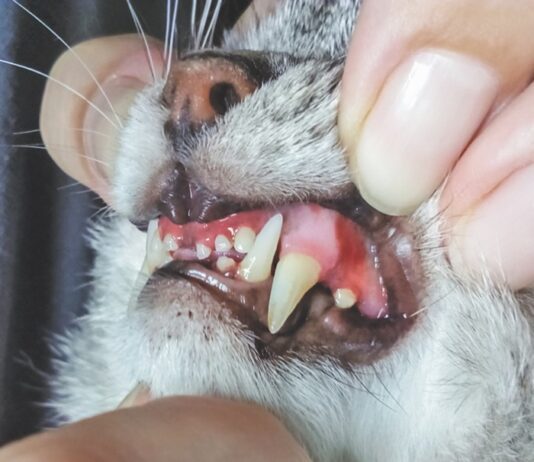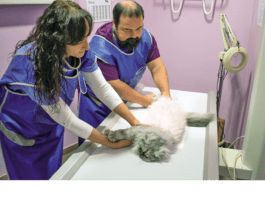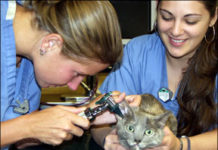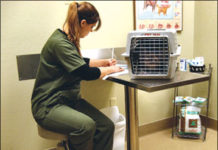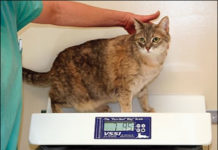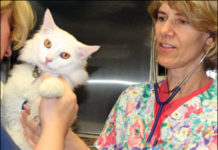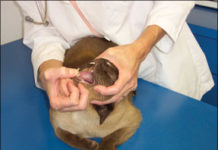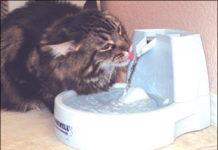The Threat of Panleukopenia
Among all agents of feline illness and mortality, few if any are more pernicious - especially to kittens - than feline panleukopenia virus (FPV). Disease resulting from infection with this virus is called panleukopenia - from the Greek words for all types (pan) of white blood cells (leuko) that are greatly reduced in number (penia). The disease is also known in some circles as "distemper," a misnomer, notes Fred Scott, DVM, PhD, a professor emeritus of virology in Cornell Universitys College of Veterinary Medicine and founding director of the Cornell Feline Health Center. "Distemper" refers to a respiratory disease, he explains, and there is no respiratory component to feline panleukopenia. Cats become infected with FPV - which is classified as a parvovirus - by living in an environment that is contaminated with it or by coming in contact with the urine, feces, saliva or nasal secretions of a cat that is already infected. "Panleukopenia is highly contagious," says Dr. Scott. "It takes only a small amount of the virus to cause infection, and the amount of virus shed by an infected cat is tremendous - probably anywhere from one billion to 10 billion viral particles per gram of fecal matter, urine or other secretions."
Diagnosis: Otitis Externa
Among all acquired feline ear disorders, the most common by far is otitis externa, an infection of the outer ear canal that, if untreated, can progress to the inner ear, damage the ear drum and seriously compromise an animals hearing as well as its sense of balance. The most common cause of this unpleasant condition and its potentially deafening consequences is an assault on the ear by an outside invader, the ear mite. In some cases, however, the culprit is an organism that normally resides harmlessly within a cats ear - a one-celled fungus, or yeast, known as Malessezia.
When Your Cat Pants
Your cat bounds up the stairs as usual. But when she gets to the top, she sits and pants - certainly not the usual. Should you worry, wait and see if she does it again or call your veterinarian immediately? In general, cats dont pant as dogs do. Dogs pant to cool themselves off, and its normal. While some cats pant from stress, pain or excitement, panting isnt usually normal for a cat, and you should probably consider taking action if it happens. What exactly is panting? Panting differs from regular breathing. Normal inhalation is an easy movement of the chest outward, with exhalation pulling the chest gently inward. Exhalation usually lasts three times longer than inhalation. The result is that entering air goes deep inside the lungs, where there is an exchange of oxygen and carbon dioxide via the blood vessels.
Short Takes: 04/08
Its one of the toughest choices a pet owner can face - between life-saving treatment and quality of life for the pet. During chemotherapy for lymphoma, the third most common form of cancer in cats, for example, the patient might lose hair, appetite, weight, sleep or even its whiskers. Some help in deciding, if the difficult time ever comes, can be found in a Journal of Feline Medicine and Surgery (Vol. 10, Issue 1) report: "Owners perception of their cats quality of life during chemotherapy for lymphoma." Of the 31 cat owners queried for the study, 25 (81 percent) said they were happy that they had treated their cat with chemotherapy, whereas three felt regretful and three were unsure of their feelings. Most of the owners (19) reported that their cats had "more good days than bad" during chemo; seven reported more bad days than good (including one cat that was miserable every day of the treatment); and four cats had "all good days." Despite the treatment, some cats did die of lymphoma or related causes. Obviously those owners were not happy with their pets eventual fate, but few regretted trying their best to save a life.
Testing for FIV and FeLV
Among all causes of lethal feline disease, none should be taken more seriously by cat owners than those caused by two specific submicroscopic organisms: feline leukemia virus (FeLV) and feline immunodeficiency virus (FIV). Although these viruses are somewhat different in appearance and in the manner in which they exact their toll on feline health, infection with either one of them, if undetected, is capable of causing a cats premature death. To make matters worse, FeLV and FIV infections are by no means rare. Recent estimates indicate that two percent to four percent of the 83 million or so cats in the U.S. harbor one or both of these two viruses.
Pyometra: A Deadly Threat
Humane considerations overwhelmingly support the practice of spaying — the surgical removal of a female cat’s ovaries and uterus — when an animal is about six months of age. Perhaps the most compelling argument in favor of this procedure (also known as ovariohysterectomy) is the reduction of feline overpopulation. One study has found that 85 percent of cats that are dropped off at shelters are eventually destroyed. It is estimated that as many as three to four million unwanted cats and kittens are put to sleep annually in the U.S.
Caring for the Cat With Chronic Illness
Would you be able to provide at-home care for your cat? Heres what to consider.
Lung Disease: A Serious Threat
Like their human counterparts, feline lungs are bag-shaped, elastic organs, two in number, located on either side of the heart and occupying most of the space in the chest cavity. They are virtually identical in structure to human lungs as well, functioning in the same manner and fulfilling the same fundamental purposes - removing carbon dioxide from the bloodstream and keeping the blood constantly supplied with life-sustaining oxygen. The lungs perform their vital functions by means of two processes - ventilation and perfusion - explains Richard Goldstein, DVM, an associate professor of small animal medicine at Cornell Universitys College of Veterinary Medicine.
What Is Cushing’s Disease?
Your cat Pinky has enjoyed good health for most of the eight years shes spent in your home. Lately, however, shes been undergoing some worrisome changes. Shes eating and drinking much more than she used to; shes recently begun to develop a potbelly; and shes become uncharacteristically lethargic. While such changes could be attributable at least in part to her advancing age, they are also signs that Pinky could be afflicted with a disorder called hyperadrenocorticism, otherwise known as Cushings disease. According to Deb Zoran, DVM, PhD, an associate professor of medicine at Texas A&M Universitys College of Veterinary Medicine and Biological Sciences, this condition is extremely rare in cats - far less frequently diagnosed than it is in dogs. Nevertheless, cat owners should be aware of Cushings disease, its causes, the clinical signs associated with it and the treatment options available.
Ask Elizabeth: 03/08
Dear Elizabeth, I am an elderly cat owner. Im old and so is my girl, Pearl. Over the years, we have gotten used to many changes in visits to our veterinarian. For example, Pearls "yearly shot" is no longer annual, and screening lab work is an expected part of her exam. These changes have been explained to me and I accept them, but there is one thing I just cant get used to. Years ago our vet would take a few minutes on the exam table to clean Pearls teeth. Pearl didnt like it much, but the vet was able to take care of her teeth without anesthesia right in the office. Now, that office procedure just isnt offered; instead our vet is recommending anesthesia for dental cleaning. Pearl has visible tartar on her teeth, but why cant my vet just clean them in the exam room?
Kidneys: Small Organs with Huge Responsibilities
Despite their relatively small size, your cats kidneys play a huge role in many life-sustaining processes.These two bean-shaped little organs - situated just behind the cats rib cage, one on either side of its spine - filter waste from the blood. In doing so, they also help control blood pressure and regulate the amount and chemical consistency of fluid in the bloodstream. In addition, they produce a variety of vitally needed hormones and enzymes and contribute to the production of red blood cells. Since about 25 percent of the blood that enters your cats circulatory system with each heartbeat travels directly to the kidneys, their well-being is essential to your cats health. Unfortunately, feline kidneys are vulnerable to a wide range of serious disorders. Indeed, kidney (renal) disease is a major cause severe illness and death in cats, especially after the age of seven years.
Feline Lymphatic Diseases
While casually petting your cat, you notice a small lump on its neck or behind one of its knees. What you may have discovered is a swollen lymph node. You dont have to be overly alarmed. The eruption is most likely a harmless and transient indication that the animal has a minor infection, and the swelling is likely to subside within a day or two. Nevertheless, youd do well to take your cat to your veterinarian for a checkup of its lymphatic system, the complex network of glands and tiny vessels that transport life-sustaining substances throughout its body. In some instances, a swollen lymph node may be a sign that the animal is harboring a potentially deadly disease.

